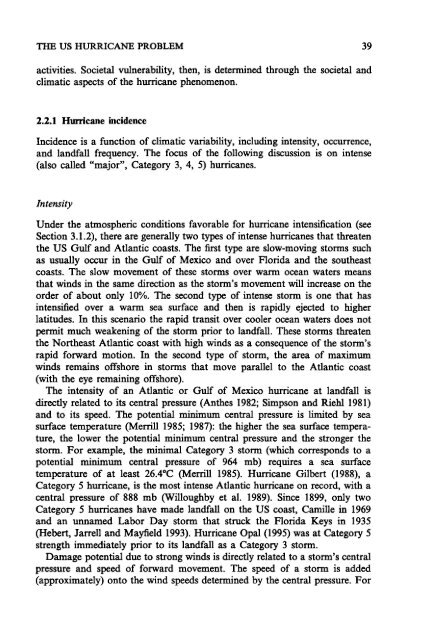Hurricanes: Their Nature and Impacts on Society - Climate Science ...
Hurricanes: Their Nature and Impacts on Society - Climate Science ...
Hurricanes: Their Nature and Impacts on Society - Climate Science ...
You also want an ePaper? Increase the reach of your titles
YUMPU automatically turns print PDFs into web optimized ePapers that Google loves.
THE US HURRICANE PROBLEM 39<br />
activities. Societal vulnerability, then, is determined through the societal <str<strong>on</strong>g>and</str<strong>on</strong>g><br />
climatic aspects of the hurricane phenomen<strong>on</strong>.<br />
2.2.1 Hurricane incidence<br />
Incidence is a functi<strong>on</strong> of climatic variability, including intensity, occurrence,<br />
<str<strong>on</strong>g>and</str<strong>on</strong>g> l<str<strong>on</strong>g>and</str<strong>on</strong>g>fall frequency. The focus of the following discussi<strong>on</strong> is <strong>on</strong> intense<br />
(also called "major", Category 3, 4, 5) hurricanes.<br />
Intensity<br />
Under the atmospheric c<strong>on</strong>diti<strong>on</strong>s favorable for hurricane intensificati<strong>on</strong> (see<br />
Secti<strong>on</strong> 3.1.2), there are generally two types of intense hurricanes that threaten<br />
the US Gulf <str<strong>on</strong>g>and</str<strong>on</strong>g> Atlantic coasts. The first type are slow-moving storms such<br />
as usually occur in the Gulf of Mexico <str<strong>on</strong>g>and</str<strong>on</strong>g> over Florida <str<strong>on</strong>g>and</str<strong>on</strong>g> the southeast<br />
coasts. The slow movement of these storms over warm ocean waters means<br />
that winds in the same directi<strong>on</strong> as the storm's movement will increase <strong>on</strong> the<br />
order of about <strong>on</strong>ly 10%. The sec<strong>on</strong>d type of intense storm is <strong>on</strong>e that has<br />
intensified over a warm sea surface <str<strong>on</strong>g>and</str<strong>on</strong>g> then is rapidly ejected to higher<br />
latitudes. In this scenario the rapid transit over cooler ocean waters does not<br />
permit much weakening of the storm prior to l<str<strong>on</strong>g>and</str<strong>on</strong>g>fall. These storms threaten<br />
the Northeast Atlantic coast with high winds as a c<strong>on</strong>sequence of the storm's<br />
rapid forward moti<strong>on</strong>. In the sec<strong>on</strong>d type of storm, the area of maximum<br />
winds remains offshore in storms that move parallel to the Atlantic coast<br />
(with the eye remaining offshore).<br />
The intensity of an Atlantic or Gulf of Mexico hurricane at l<str<strong>on</strong>g>and</str<strong>on</strong>g>fall is<br />
directly related to its central pressure (Anthes 1982; Simps<strong>on</strong> <str<strong>on</strong>g>and</str<strong>on</strong>g> Riehl 1981)<br />
<str<strong>on</strong>g>and</str<strong>on</strong>g> to its speed. The potential minimum central pressure is limited by sea<br />
surface temperature (Merrill 1985; 1987): the higher the sea surface temperature,<br />
the lower the potential minimum central pressure <str<strong>on</strong>g>and</str<strong>on</strong>g> the str<strong>on</strong>ger the<br />
storm. For example, the minimal Category 3 storm (which corresp<strong>on</strong>ds to a<br />
potential minimum central pressure of 964 mb) requires a sea surface<br />
temperature of at least 26.4°C (Merrill 1985). Hurricane Gilbert (1988), a<br />
Category 5 hurricane, is the most intense Atlantic hurricane <strong>on</strong> record, with a<br />
central pressure of 888 mb (Willoughby et al. 1989). Since 1899, <strong>on</strong>ly two<br />
Category 5 hurricanes have made l<str<strong>on</strong>g>and</str<strong>on</strong>g>fall <strong>on</strong> the US coast, Camille in 1969<br />
<str<strong>on</strong>g>and</str<strong>on</strong>g> an unnamed Labor Day storm that struck the Florida Keys in 1935<br />
(Hebert, Jarrell <str<strong>on</strong>g>and</str<strong>on</strong>g> Mayfield 1993). Hurricane Opal (1995) was at Category 5<br />
strength immediately prior to its l<str<strong>on</strong>g>and</str<strong>on</strong>g>fall as a Category 3 storm.<br />
Damage potential due to str<strong>on</strong>g winds is directly related to a storm's central<br />
pressure <str<strong>on</strong>g>and</str<strong>on</strong>g> speed of forward movement. The speed of a storm is added<br />
(approximately) <strong>on</strong>to the wind speeds determined by the central pressure. For














